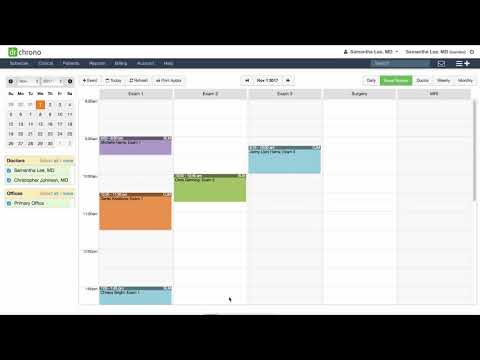How to Schedule Appointments as a Medical Assistant
Contents [show]
Find out how to schedule appointments as a medical assistant This guide covers the basics of scheduling appointments and offers tips to make the process run smoothly.
Checkout this video:
Appointment Scheduling Process
The medical assistant job description often includes making appointments for patients. The steps in the appointment scheduling process are to gather patient information, confirm the appointment with the patient, schedule the appointment, and send a confirmation to the patient.
When you gather patient information, you will need the patient’s name, date of birth, contact information, and insurance information. You will also need to know the reason for the visit so that you can schedule an appropriate amount of time for the appointment.
Once you have all of the necessary information, you will confirm the appointment with the patient. This is important to do because it allows you to make sure that all of the details are correct and that the patient is still planning to come in for their appointment.
After confirming the appointment with the patient, you will schedule it in your office’s system. Make sure to include any specific instructions that the doctor has given you regarding the scheduling of this particular appointment.
Finally, send a confirmation to the patient so that they have all of the details about their upcoming appointment. This confirmation can be sent via email or mail.
Appointment Scheduling Tips
As a medical assistant you will often be responsible for scheduling appointments for patients. Here are a few tips to keep in mind when scheduling appointments:
-Be sure to check with the patient’s insurance company to confirm coverage and benefits.
-Schedule appointments at a time that is convenient for the patient. Keep in mind that some appointments, such as follow-up visits, may need to be scheduled during specific days or times.
-If the appointment is for a procedure or test, be sure to schedule it far enough in advance so that the patient has time to prepare mentally and emotionally.
-Make sure to schedule enough time for the appointment so that the patient does not feel rushed.
-Allow extra time for new patients so that they can fill out paperwork.
-If the patient needs to see a specialist, be sure to check referral requirements and make any necessary arrangements in advance.
Appointment Scheduling Software
There are a number of software programs available to Medical assistants for scheduling appointments. Some of these programs are designed specifically for medical offices, while others are more general purpose. Regardless of the type of program you choose, there are a few key features to look for to make sure the program will work well for your needs.
First, you’ll want to make sure the program can handle multiple appointment types. Different types of appointments will have different duration times, and you’ll need to be able to schedule them accordingly. The program should also be able to handle multiple providers, so that each provider can have their own schedule.
Second, you’ll want to make sure the program can generate reminders for both patients and providers. Patients should be reminded of their upcoming appointments, so that they can make any necessary preparations. Providers should also be reminded of their appointments, so that they can plan their day accordingly.
Third, you’ll want to make sure the program can integrate with other systems in your office. This might include your electronic medical records system, your billing system, or your appointment reminder system. This integration will make it easier for you to keep track of all your appointments in one place.
fourth, you’ll want to choose a program that’s easy to use. It should be intuitive and easy to learn, so that you don’t waste time trying to figure out how it works. Look for a program with good customer support in case you run into any problems.
Appointment Scheduling Best Practices
Scheduling appointments is one of the most important duties of a medical assistant In order to ensure that appointments are scheduled properly, Medical Assistants should follow best practices for scheduling appointments.
Some of the best practices for appointment scheduling include:
– Schedule appointments in advance: One of the best ways to ensure that appointments are scheduled properly is to schedule them in advance. This allows medical assistants to have time to check for conflicts and to make sure that all of the necessary information is gathered prior to the appointment.
– Use a scheduling system:Another way to ensure that appointments are scheduled properly is to use a scheduling system. Scheduling systems help to keep track of all of the information related to an appointment, including the time, date, and location. This information can be easily accessed by both medical assistants and patients.
– Communicate with patients: It is important for medical assistants to communicate with patients about their appointment schedule. Medical assistants should make sure that patients understand when their appointment is and where they need to go. Patients should also be given instructions on how to cancel or reschedule their appointment, if necessary.
Appointment Scheduling for New Patients
As a medical assistant, you will often be responsible for scheduling appointments for new patients. This can be a tricky task, as you will need to consider the availability of both the patient and the doctor. In addition, you will need to take into account the length of the appointment and any other appointments that may be scheduled around it. Follow the tips below to learn how to schedule appointments as a medical assistant.
Appointment Scheduling for Established Patients
As a medical assistant, you will often be responsible for scheduling appointments for established patients. Here are some tips to help you do so:
1. Check the patient’s chart for any restrictions on appointment times. For example, some patients may only be able to come in during certain hours due to work or child care commitments.
2. Make sure to schedule the appointment at a time that is convenient for both the patient and the doctor. Keep in mind that the doctor’s schedule may be full and that you will need to work around other appointments.
3. Select an appointment time that is appropriate for the type of appointment. For example, a physical exam will take longer than a routine check-up, so make sure to allot enough time.
4. Once you have selected an appointment time, call the patient to confirm the date and time. Be sure to ask if there are any changes to their availability or if they have any questions about the appointment.
Appointment Scheduling for Specialty Care
As a medical assistant, you may be responsible for scheduling appointments for patients to see specialists. While the process of scheduling an appointment is similar to scheduling a regular doctor’s appointment, there are a few important things to keep in mind when making an appointment with a specialist.
1. Make sure you have all the necessary information about the patient before making the call. You will need the patient’s name, date of birth, insurance information, and the reason for the visit.
2. When you call to schedule the appointment, be sure to ask if there are any specific instructions that you need to follow when making the appointment. For example, some specialists may require that you fax over certain information before they can schedule an appointment.
3. Ask what types of insurance the specialist accepts and verify that the patient’s insurance will cover the visit. Some specialists only accept certain types of insurance, so it’s important to ask this question up front.
4. Find out how far in advance appointments need to be scheduled. Some specialists may have a waiting list, so it’s important to schedule an appointment as soon as possible.
5. Ask if there are any special instructions that the patient needs to know about before coming in for the appointment (e.g., fasting for bloodwork).
6. Make a note of the time and date of the appointment and give this information to the patient along with any other instructions that they need to follow before coming in for their visit.
Appointment Scheduling for Emergency Care
As a medical assistant, you will need to know how to schedule appointments for your patients. There are many different types of appointment scheduling, but emergency care is one of the most important. Here are some tips on how to schedule appointments for emergency care.
1. Always check with the patient’s insurance company to ensure that they will be covered for the appointment.
2. If the patient does not have insurance, or if their insurance will not cover the cost of the appointment, try to work out a payment plan with them.
3. Make sure that you schedule the appointment for a time when the patient will be able to make it. This may mean making appointments outside of normal business hours.
4. Always make sure that you confirm the appointment with the patient, either by phone or in person, before they leave your office.
Appointment Scheduling for Telemedicine
In recent years, telemedicine has become an increasingly popular way for patients to receive medical care. Rather than travelling to a doctor’s office or hospital, patients can now receive a wide range of medical services from the comfort of their own homes.
As a medical assistant, you may be responsible for scheduling appointments for patients who wish to receive care via telemedicine. While the process of scheduling an appointment is similar to scheduling a traditional in-person appointment, there are a few key considerations that you will need to keep in mind.
When scheduling an appointment for a patient who will be receiving care via telemedicine, it is important to first verify that the patient has the equipment and internet connection necessary to participate in the appointment. In some cases, the doctor or healthcare provider may be able to provide the necessary equipment; in other cases, it may be the responsibility of the patient to obtain the necessary equipment prior to the appointment.
You will also need to determine whether the appointment will be conducted using audio only, video only, or both audio and video. This information is important as it will determine how long the appointment will last and what type of equipment will be necessary.
Once you have gathered all of the necessary information, you will be able to schedule the appointment using the same software or system that you would use to schedule a traditional in-person appointment. Be sure to include all relevant information about the appointment (e.g., date and time, type of appointment, etc.) so that both the patient and healthcare provider are prepared for the visit.
Appointment Scheduling for Military and Veterans
As a medical assistant, it’s important to know how to schedule appointments for military and veteran patients. There are a few things to keep in mind when scheduling appointments for these patients.
First, you will need to verify the patient’s insurance coverage. Scheduling an appointment without knowing if the patient’s insurance will cover the cost of care can result in issues down the road.
Next, you will need to check for any appointment restrictions. For example, some military and veteran patients may only be able to see certain providers or may have other appointment restrictions in place. Be sure to check for these restrictions before scheduling an appointment.
Finally, you will need to make sure that the provider you are scheduling an appointment with is approved by the patient’s insurance company. If the provider is not approved, the patient may have to pay out of pocket for their care.
Keep these things in mind when scheduling appointments for military and veteran patients and you’ll be sure to provide them with quality care.







